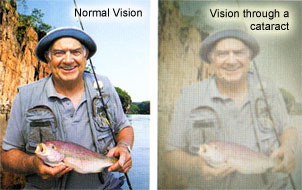Understanding Cataracts
A Natural Effect Of Aging
The eye's natural crystalline lens helps us focus on people and things at varying distances. Unfortunately, as we grow older this lens often stiffens and hardens, and without its youthful suppleness, it loses its ability to focus, creating vision problems. This condition - for most, a natural consequence of aging - is called presbyopia. Some people begin experiencing the early effects of presbyopia (such as gradual loss of near vision) in their mid-40s.
As we age, these changes occurring to the natural crystalline lens can lead to the development of cataracts. By age 65, a large percentage of us will develop a cataract, most often typified by cloudy/fuzzy vision. With a cataract you may have difficulty seeing in extremely bright light or low lighted conditions.

Improving Your Vision
Developing a cataract doesn't mean a permanent loss of vision quality, or having to give up the things you love, because cataract surgery is a safe, effective way to improve your vision. Cataract surgery is the most commonly performed surgery in the United States, with well over 2 million Americans having the procedure every year. Performed almost exclusively on an outpatient basis, cataract surgery is microsurgery, whereby the natural lens is removed and replaced with what is called an intraocular lens (IOL). The procedure is highly successful and most people regain very good distance vision, somewhere between 20/20 and 20/40.
During cataract surgery, your physician will replace your natural lens with an IOL. Today there are multiple types of IOLs, each delivering a different performance profile based on how the lens is designed. Here are the basics about the three main types of IOLs:
Standard Monofocal IOLs
 A standard monofocal IOL is a fixed lens (it doesn't move) that is designed to deliver improved vision at just one distance (usually far). The potential drawback is that after surgery, you will probably need to wear glasses for near and intermediate vision, even if you didn't wear glasses before surgery.
A standard monofocal IOL is a fixed lens (it doesn't move) that is designed to deliver improved vision at just one distance (usually far). The potential drawback is that after surgery, you will probably need to wear glasses for near and intermediate vision, even if you didn't wear glasses before surgery.
Multifocal IOLs
 A multifocal lens uses multiple visual zones that are built into the lens itself to provide vision at various distances. It's almost like the rings of a target, with some rings being dedicated to distance vision, while others are used for near vision, similar to having a bifocal or trifocal lens inside the eye. A multifocal IOL projects multiple images, requiring your brain to adjust to the differences. Some patients have difficulty adjusting to seeing this way. Additionally, intermediate vision (subject at arms length) can be compromised because the technology is designed mainly for near and distance vision, at the exclusion of intermediate vision. With multifocal IOLs, patients can have potential issues of glare and halos especially when driving at night.
A multifocal lens uses multiple visual zones that are built into the lens itself to provide vision at various distances. It's almost like the rings of a target, with some rings being dedicated to distance vision, while others are used for near vision, similar to having a bifocal or trifocal lens inside the eye. A multifocal IOL projects multiple images, requiring your brain to adjust to the differences. Some patients have difficulty adjusting to seeing this way. Additionally, intermediate vision (subject at arms length) can be compromised because the technology is designed mainly for near and distance vision, at the exclusion of intermediate vision. With multifocal IOLs, patients can have potential issues of glare and halos especially when driving at night.
Accommodating IOLs
 As the name implies, an accommodating lens "flexes" or "accommodates" using the eyes natural muscles to focus on subjects at various distances, delivering a continuous range of vision - near, intermediate and far. crystalens is the one and only FDA-approved accommodating lens available in the United States. crystalens can reduce or eliminate your dependence on glasses. More than twice the number of patients implanted with crystalens could see at all distances compared to a standard IOL.
As the name implies, an accommodating lens "flexes" or "accommodates" using the eyes natural muscles to focus on subjects at various distances, delivering a continuous range of vision - near, intermediate and far. crystalens is the one and only FDA-approved accommodating lens available in the United States. crystalens can reduce or eliminate your dependence on glasses. More than twice the number of patients implanted with crystalens could see at all distances compared to a standard IOL.

